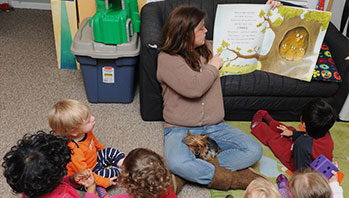- Flower Garden (book)
- Jack’s Garden (book)
- flower
- garden
- plant
- water
MA Standards:
English Language Arts/Literature/RL.PK.MA.1: With prompting and support, ask and answer questions about a story or a poem read aloud.
English Language Arts/Literature/RL.PK.MA.4: With prompting and support, ask and answer questions about unfamiliar words in a story or poem read aloud.
English Language Arts/Literature/RL.PK.MA.10: Listen actively as an individual and as a member of a group to a variety of age-appropriate literature read aloud.
English Language Arts/Literature/RL.PK.MA.9: With prompting and support, make connections between a story or poem and one’s own experiences.
Head Start Outcomes:
Literacy Knowledge/Book Appreciation and Knowledge: Asks and answers questions and makes comments about print materials.
PreK Learning Guidelines:
English Language Arts/Reading and Literature 6: Listen to a wide variety of age appropriate literature read aloud.
English Language Arts/Reading and Literature 10: Engage actively in read-aloud activities by asking questions, offering ideas, predicting or retelling important parts of a story or informational book.
Read Together: Flower Garden #2

© Commonwealth of Massachusetts, Department of Early Education and Care (Jennifer Waddell photographer). All rights reserved.
STEM Key Concepts: Plants start in different ways; Some plants start from seeds; Some plants start from bulbs; Plants grow in many places; Plants have different parts: roots, stems, leaves, and fruit; Plants need water and sunlight to grow; Plants grow in places where they get their needs met; Plants often grow in some type of dirt
ELA Focus Skills: Concepts of Print, Interpreting Illustrations, Listening and Speaking, Story Comprehension, Vocabulary
Before You Read
Hold up the cover of Flower Garden by Eve Bunting and tell children you are going to read the story to them again. Then point to the words as you read the title and the names of the author and illustrator. Ask, What parts of the cover help you know what this book will be about? (title, illustration)
Set a listening focus for children by asking them to think about how the girl’s garden is similar and different to the garden in Jack’s Garden.
As You Read
Pause to notice the details in the illustrations.
- Point to the flowers on the checkout counter and ask, Where do you think stores get the flowers and plants they sell to people? Explain that grocery stores do not grow plants from seeds, they buy them from farms and plant farms. Ask, What other kinds of plants do you think grocery stores buy from farms? (fruit, vegetables).
- Point out what things the girl and her dad are doing as they plant the flowers. (put in dirt, put on windowsill for light/air)
After You Read
Have Jack’s Garden on display as you ask children to compare. Ask questions and show the corresponding illustrations to support children’s answers.
- Do you think the little girl and her dad planted their garden for the same reason Jack did? What do you think the reason is?
- What is similar about the needs of the little girl’s plants and Jack’s plants?
- Point out that both gardens are planted in soil. Ask, What do you think is different about the soil the little girl and her dad used and the soil Jack used to plant in? (from the store/in the ground; no worms, rocks, etc./worms, rocks, etc.)
- Why do you think the little girl planted in a small space and Jack planted in a big space?
